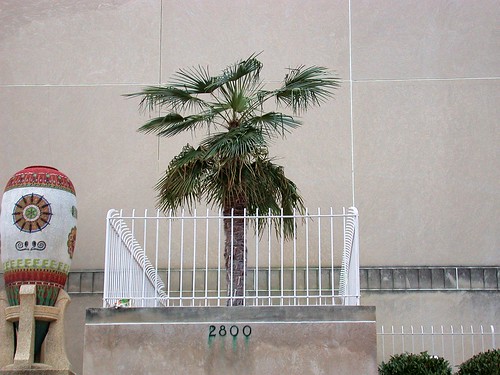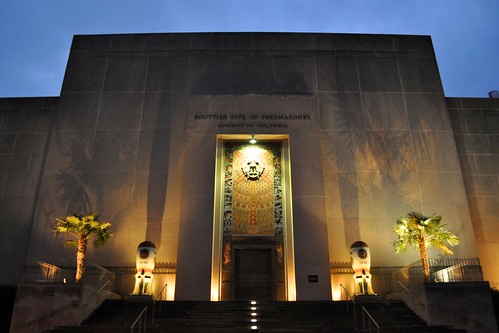Scottish Rite Temple, December 2009 (Photo: Kenneth Fletcher)
In summer 2009 an interesting thing happened. The Scottish Rite Temple on 16th Street in Washington, DC--just blocks from where I live--had new landscaping installed that included two good-sized palm trees flanking the front entrance. The palms were palmettos, Sabal palmetto, a species native to the southeastern USA. This had various palm growers scratching our heads; were they meant to be permanent? If so, they were a poor choice as this species isn't hardy in zone 7, and planting so late in the growing season would give them insufficient time to establish themselves before winter. But if they were meant to be temporary plantings, it seemed rather expensive and extravagant.
Curious, I emailed the organization to inquire, and received a reply that they were indeed intended to be permanent, but that they were "windmill palms" and hardy to -10 degrees. Clearly, whoever installed these palms had provided them with faulty information. These were certainly not windmill palms (Trachycarpus fortunei, an Asian species) and not even that species would be reliably hardy at -10 degrees. Going into their first winter, the palm growing community watched and waited. I predicted at the time that the palms would not survive any but the mildest winters in Washington, DC.

January 2010 (photo: M.V. Jantzen)
I should know better by now than to make such predictions. To my surprise (and embarrassment), both palms survived their first winter, but the cold weather had taken a heavy toll and by spring they looked pretty rough:

May 2010 (photo: M.V. Jantzen)
Although they had survived, the palms were in serious trouble. One of the problems is that Sabal palmetto is a relatively slow-growing palm. During the 2010 growing season the palms grew a few new fronds, but failed to attain the crown they had lost from the previous year and went into their second winter severely weakened. Once again they came through with a bit of green but the cumulative damage and scanty re-growth had taken a heavy toll. By June 2011, one of the palms had died and the other was in serious decline.

June 2011
Shortly after the above photo was taken, the sorry-looking palms were removed and replaced with proper windmill palms (Trachycarpus fortunei), a far better choice as this species is both hardier and faster-growing than Sabal palmetto. There are numerous windmill palms in the Washington, DC area that have survived multiple winters, and even if they suffer winter damage they recover quickly, putting out a full crown of leaves after a single growing season.

October 2012
Since they were planted in 2011, the palms have experienced two unusually warm winters and come through virtually unscathed. This winter will be the real test, as we are getting our third (and hopefully final!) visit this month from the "polar vortex", giving DC our coldest temperatures in 20 years and one of our coldest Januaries in decades. The low temperatures are bad enough, but the repeated cold spells--often accompanied by wind--with extended periods remaining well below freezing are taking a toll on hardy palms in the area, including these. From a distance they don't look too bad, but up close it's apparent that they have suffered damage.

Late January, 2014

Late January, 2014
There are going to be many sad-looking windmill palms this spring. The important thing to remember is that palms that may look dead aren't necessarily beyond hope; windmill palms can suffer massive damage and still put out new growth the following spring. The new growth may not appear until well into the summer, and in the meantime the palms will look like they've been to hell and back... but give them a chance and they just might surprise us all!
The Scottish Rite Temple palms have a good chance of surviving. They are planted in a very good location, on the east (downwind) side of a massive stone building that retains and radiates heat while protecting them from wind. They certainly look better than the freeze-dried palms in my own back yard, just a few blocks away. I do hope these palms will survive. I think they are a good addition to the building and frame the entrance very nicely, and are especially dramatic when lit at night:

Scottish Rite Temple, January 2012. (photo: M.V. Jantzen)

That last photo is just gorgeous. I'm pulling for these (and your) palms!
ReplyDeleteWish that photo was my own, but it was taken by a friend of mine! I'm optimistic that these palms are going to make it, I'm just worried that the building's owners will think they're dead and rip them out this spring. I've sent them an email with a link to this blog post, and suggested that however bad the palms look, they wait until summer before pronouncing them dead!
DeleteI don't know about the DC area, but in Seattle Trachycarpus palms of that size would cost upwards of $500. They are very slow growing when young. Those in the photo have to be at least 10 years old, probably a lot older.
ReplyDeleteI hope they didn't have to pay because they were replacements for misidentified palms that should never have been planted in the first place! I do have to wonder how much the original palmettos cost--between shipping and installation, palms that size probably cost a pretty penny.
DeleteI'm sure in that microclimate they should rebound just fine, but you ask a valid question; will the institution wait for them to regrow before replacing them with "Boxwoods"! Although I always laugh when the anti Boxwood palm people lash out at Buxus!
ReplyDeleteI noticed a few days ago that the palms at both locations are still standing, with the old and dead leaves cut off. One of the Scottish Rite palms is definitely putting out new growth, and one of the Smithsonian palms as well--but it looks like their companions at both locations may be dead.
Delete